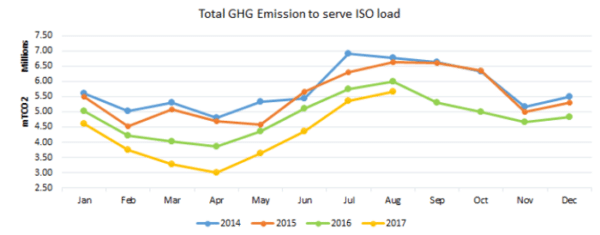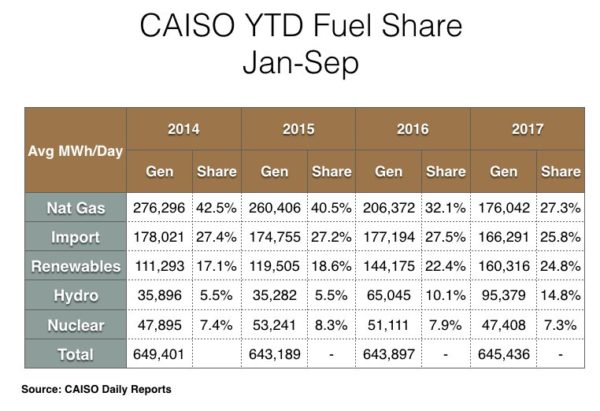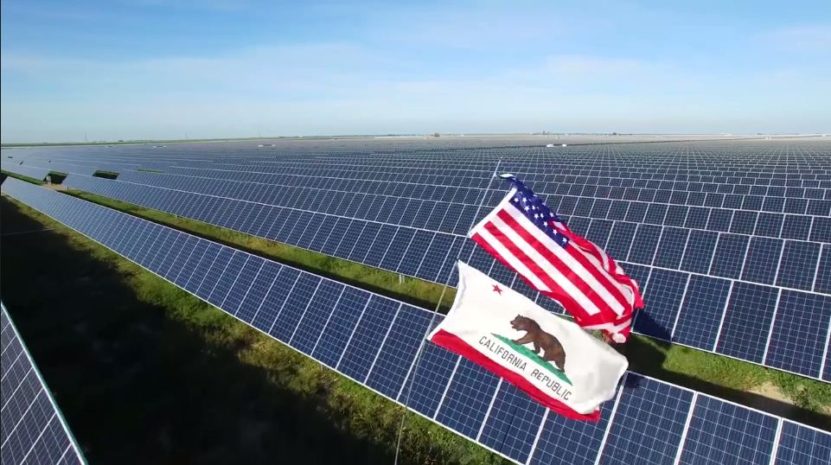It’s no secret that California is leading leading the Energy Transition in the United States, including achieving the highest portion of solar on its grid of any state. The latest data from the state’s grid operator is also showing that this is accompanied by an ongoing decline in natural gas usage, as well as a lower level of electricity imports – despite an increasingly sophisticated network of electricity trading with other grids.
A September 30 report by the California Independent System Operator (CAISO) shows that greenhouse gas emissions – both from in-state generation and imports – fell to 33.64 million tons of CO2 in the first eight months of 2017.

This represents at least the third straight year of decline, and is 26% lower than in the first eight months of 2014.
Much of this is due to the increase in hydroelectric generation, a result of record rainfall in California over the last two years. CAISO data for the first nine months of 2017, as compiled by Joe Deely shows that hydro generation met 5.5% of demand in the first nine months of 2014 and 2015, but this rose to over 10% in 2016 and 14.8% in 2017.
 This data also shows non-hydro renewable energy climbing to 24.8% of demand, which represents the third straight year of increase. During this time natural gas fell from 42.5% to 27.3% of demand, with even imports falling from 2016 to 2017.
This data also shows non-hydro renewable energy climbing to 24.8% of demand, which represents the third straight year of increase. During this time natural gas fell from 42.5% to 27.3% of demand, with even imports falling from 2016 to 2017.
This means that all sources of renewable energy met 39.6% of demand during this period. Along with generation from California’s sole remaining nuclear power plant, sources of in-state generation that do not emit greenhouse gases met 47% of California’s electricity demand – up from 30% in 2014.
This is strong evidence as to why California authorities are now rejecting proposals for new gas plants and even repowering projects for existing plants, given that renewables are increasingly meeting demand.
As this happens, CAISO is also expanding its Electricity Imbalance Market (EIM), which allows for the rapid trading of electricity with its neighbors. Earlier this week Portland General Electric joined the EIM, as the fifth grid operator outside of California to become part of the real-time energy market. CAISO notes that EIM is both providing cost benefits and allowing for more efficient dispatch of renewable resources over a larger area.
This content is protected by copyright and may not be reused. If you want to cooperate with us and would like to reuse some of our content, please contact: editors@pv-magazine.com.









By submitting this form you agree to pv magazine using your data for the purposes of publishing your comment.
Your personal data will only be disclosed or otherwise transmitted to third parties for the purposes of spam filtering or if this is necessary for technical maintenance of the website. Any other transfer to third parties will not take place unless this is justified on the basis of applicable data protection regulations or if pv magazine is legally obliged to do so.
You may revoke this consent at any time with effect for the future, in which case your personal data will be deleted immediately. Otherwise, your data will be deleted if pv magazine has processed your request or the purpose of data storage is fulfilled.
Further information on data privacy can be found in our Data Protection Policy.